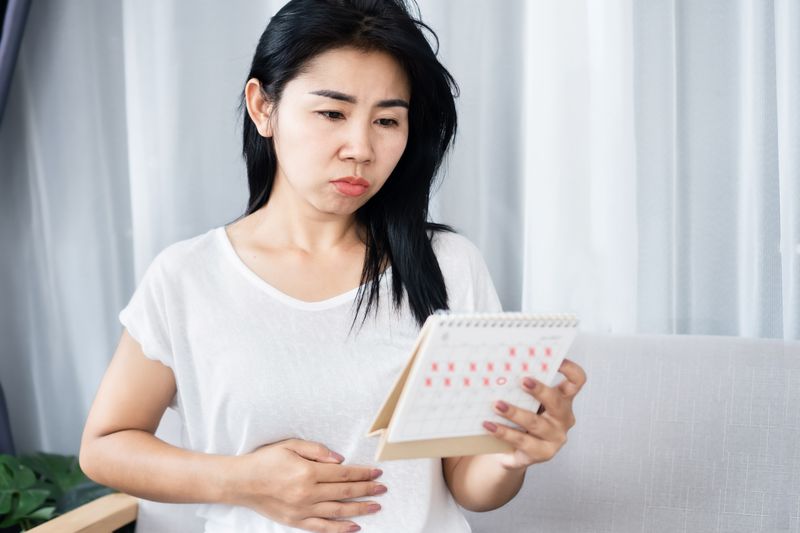15 Things Your Period Says About Your Health—At Any Age

Your monthly period is more than just a reproductive event—it’s a window into your overall health. Those regular cycles can reveal important clues about what’s happening inside your body, from hormone levels to potential medical conditions. Understanding these signals helps you take control of your health and know when to seek medical advice.
1. Heavy Flow Requires Attention

Soaking through protection every hour or passing large clots bigger than a quarter isn’t just inconvenient—it’s potentially serious. Excessive bleeding can lead to anemia, causing fatigue and weakness that impacts daily life.
Fibroids, polyps, or adenomyosis might be behind the flood. Women approaching menopause often experience heavier periods as hormone levels fluctuate.
Don’t suffer through super-soaker cycles thinking they’re normal. Modern treatments ranging from medication to minimally invasive procedures can help manage heavy bleeding and improve quality of life.
2. Painful Cramps Beyond Normal

Mild discomfort during your period is one thing, but pain that keeps you from normal activities deserves medical attention. Severe cramping might signal endometriosis, where tissue similar to uterine lining grows outside the uterus.
Adenomyosis, fibroids, or pelvic inflammatory disease can also cause intense pain. Many women suffer for years believing extreme period pain is just their lot in life.
Heat therapy, over-the-counter pain relievers, and gentle exercise provide temporary relief. But don’t hesitate to seek professional help—treatments exist that can significantly reduce or eliminate debilitating period pain.
3. Color Changes Tell Stories

The color of your menstrual blood carries meaningful health information. Bright red indicates fresh blood flowing quickly from the uterus, while darker shades suggest slower flow, giving blood time to oxidize.
Brown or black blood typically appears at the beginning or end of your period and is completely normal. However, persistent gray or off-white discharge with a foul odor could indicate infection and requires immediate medical attention.
Orange-tinged flow might mean blood is mixing with cervical fluid, while pink could signal low estrogen levels, especially in very active women or those with restrictive diets.
4. Missing Periods Beyond Pregnancy

Skipped periods aren’t always about baby news. Amenorrhea—the absence of menstruation—can stem from multiple causes including extreme exercise, significant weight loss, or high stress levels. Your body essentially decides reproduction isn’t a priority when resources are limited.
Hormone disorders like PCOS or thyroid conditions commonly cause missed periods. Early menopause, certain medications, and structural problems in the reproductive organs are other possible culprits.
Missing three or more consecutive periods (when you’re not pregnant) warrants a conversation with your healthcare provider to identify and address the underlying cause.
5. Spotting Between Cycles

Light bleeding between regular periods often catches women off guard. Hormonal fluctuations, especially during ovulation, commonly cause mid-cycle spotting. Birth control pills can trigger breakthrough bleeding, particularly during the first few months of use.
More concerning causes include polyps, fibroids, infection, or rarely, precancerous or cancerous conditions. Physical causes like vigorous exercise or sexual activity sometimes lead to temporary spotting.
Keep track of when spotting occurs and what else is happening in your life at that time. This information helps doctors determine whether the bleeding is normal variation or requires further investigation.
6. Irregular Timing Speaks Volumes

Periods that show up unexpectedly or skip months altogether might be your body waving a red flag. While some variation is normal, consistently unpredictable cycles could signal hormone imbalances, thyroid issues, or polycystic ovary syndrome (PCOS).
Stress and significant weight changes also commonly disrupt your cycle’s timing. If you can predict your period about as well as you can predict the weather, it’s worth mentioning to your doctor.
Tracking your periods for several months provides valuable information that helps healthcare providers spot patterns and potential problems early.
7. PMS Intensity Fluctuations

The emotional roller coaster before your period isn’t just in your head. Premenstrual symptoms result from real hormonal changes affecting brain chemistry. Severe PMS might indicate conditions like premenstrual dysphoric disorder (PMDD) or underlying depression and anxiety disorders.
Thyroid imbalances often masquerade as PMS, worsening mood swings and irritability. Tracking symptoms helps identify patterns and triggers that can be addressed through lifestyle modifications or medical treatment.
Regular exercise, adequate sleep, and stress management techniques provide natural relief for many women. Diet changes like reducing caffeine, salt, and sugar often improve symptoms significantly.
8. Clot Size Matters

Blood clots during your period are usually normal, especially on heavier flow days. Small clots (smaller than a quarter) form as the body releases anticoagulants to keep menstrual blood flowing smoothly from the uterus.
Larger or more frequent clots might indicate fibroids, polyps, hormone imbalances, or other medical conditions affecting the uterine lining. Women approaching perimenopause often notice increased clotting as hormone levels begin to fluctuate.
Taking note of clot size, frequency, and when they occur during your cycle provides valuable information for healthcare providers assessing your reproductive health.
9. Cycle Length Changes

Your cycle’s overall length naturally evolves throughout your reproductive years. Teenagers often experience irregular cycles as their hormones stabilize, while women in their 20s and 30s typically enjoy more predictable patterns.
Approaching perimenopause, cycles may shorten before becoming more irregular. Sudden changes in previously stable cycles can indicate pregnancy, stress, thyroid disorders, or PCOS.
The average cycle lasts 21-35 days, measured from the first day of one period to the first day of the next. Cycles consistently falling outside this range deserve medical attention, as they might signal hormone imbalances affecting overall health.
10. Period Duration Shifts

Most periods last 3-7 days, with flow typically heaviest during the first few days. Bleeding lasting longer than a week might indicate conditions like fibroids, polyps, or hormone imbalances affecting how the uterine lining builds up and sheds.
Very short periods sometimes signal low estrogen levels, especially in women who exercise intensely or maintain very low body fat. Stress and thyroid disorders can also shorten bleeding duration.
Pay attention to how your period length changes over time. Gradual shifts often reflect normal aging, while sudden changes might need medical evaluation to rule out underlying health concerns.
11. Unusual Odors Signal Problems

Menstrual blood typically has a slight metallic smell due to its iron content. When exposed to air, this scent becomes more noticeable but shouldn’t be overpowering or foul.
Strong fishy or rotten odors during your period often indicate bacterial infections like bacterial vaginosis or forgotten tampons. These require prompt medical attention to prevent complications.
Good hygiene practices help manage normal period odors. Change menstrual products regularly, wash the external genital area with mild soap and water, and wear breathable cotton underwear. If unusual smells persist despite these measures, consult your healthcare provider.
12. Period Blood Consistency Changes

The texture of your menstrual flow varies naturally throughout your cycle. Early and late days often feature thicker, more mucus-like discharge, while mid-period flow tends to be more liquid.
Very watery periods sometimes indicate low progesterone levels or could signal a very early miscarriage. Unusually thick, jelly-like consistency might mean higher estrogen levels or reflect how long the blood has been collecting in the uterus.
Consistency changes accompanied by significant pain, fever, or unusual odor warrant medical attention. Otherwise, variations in texture throughout your cycle and from month to month are typically normal.
13. Sudden Changes After 40

Perimenopause brings noticeable period changes as your reproductive years wind down. Cycles might become shorter, longer, heavier, lighter, or skip entirely as hormone levels fluctuate unpredictably.
While these changes are expected, certain symptoms deserve prompt medical attention. Heavy bleeding that soaks through protection hourly, periods lasting more than seven days, or bleeding after sex require evaluation to rule out more serious conditions.
Many perimenopausal women benefit from keeping a symptom journal to help doctors distinguish between normal aging changes and potential health concerns. This transition typically begins in your 40s but can start earlier.
14. Teen Period Patterns Matter

The first few years after menstruation begins naturally feature irregular cycles as the body’s hormone systems mature. However, extremely heavy bleeding, severe pain that interferes with daily activities, or periods consistently lasting longer than seven days aren’t normal growing pains.
These symptoms might indicate conditions like bleeding disorders, endometriosis, or PCOS that are better addressed early. Tracking periods from the start helps establish baselines and identify potential problems.
Parents should help young teens understand what’s normal and encourage open conversations about period concerns. Early intervention for menstrual disorders can prevent years of unnecessary suffering and protect future fertility.
15. Period-Related Digestive Issues

Bathroom troubles often tag along with your period thanks to prostaglandins, hormone-like substances that cause uterine contractions and can affect your digestive tract too. Diarrhea, constipation, and bloating commonly occur before or during menstruation.
More severe digestive symptoms might indicate endometriosis involving the bowel or inflammatory bowel disease that flares with hormonal changes. Some women notice food sensitivities worsen during their periods due to increased inflammation.
Tracking digestive symptoms alongside your cycle helps identify patterns and potential triggers. Simple remedies like heat therapy, gentle exercise, and avoiding gas-producing foods can provide relief for most women.

Comments
Loading…